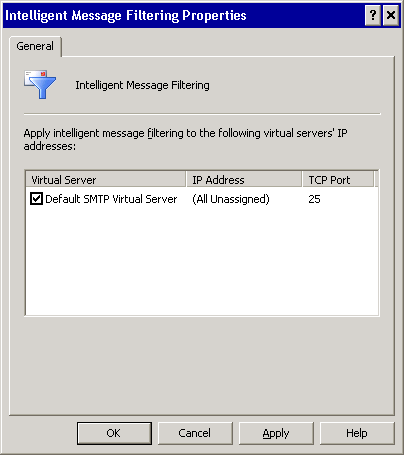Topic Last Modified: 2006-05-17
The Microsoft® Exchange Server Analyzer Tool reads the following registry entry to determine whether Microsoft Exchange Intelligent Message Filter is installed and enabled on the server:
HKEY_LOCAL_MACHINE\ Software\Microsoft\Exchange\ContentFilter
The Exchange Server Analyzer reads the ContentFilterBindings value in the ContentFilter registry key to determine whether Intelligent Message Filter is installed and enabled on the server.
The Exchange Server Analyzer then queries the CIM_Datafile Microsoft Windows® Management Instrumentation (WMI) class to determine whether the Exchange Server 2003 Service Pack 1 (SP1) version of Intelligent Message Filter MSExchange.UceContentFilter.dll is in the following path on the Exchange Server:
<path to Exchange server binary files>\MSCFv1\MSExchange.UceContentFilter.dll
 Note: Note: |
|---|
| In this path, <path to Exchange server binary files> refers to the location of the bin folder. |
If the Exchange Server 2003 SP1 version of Intelligent Message Filter is installed and enabled on the server, the Exchange Server Analyzer displays a warning.
This warning indicates that a more recent version of Intelligent Message Filter is available. It is recommended that you install the latest version of Intelligent Message Filter. If you are troubleshooting mail flow issues that involve this particular server, you may want to temporarily disable the Intelligent Message Filter to determine whether it is incorrectly blocking legitimate mail.
To Disable Intelligent Message Filter-
Click Start, point to All Programs, point to Microsoft Exchange, and then click System Manager.
-
In Exchange System Manager, expand Servers, expand Server name, expand Protocols, expand SMTP, right-click Intelligent Message Filtering, and then click Properties.
-
On the General tab, under Apply intelligent message filtering to the following virtual servers' IP addresses, clear the check box next to each SMTP virtual server on which you want to disable Intelligent Message Filter.

The Intelligent Message Filtering Properties dialog box
For more information, see the Exchange Intelligent Message Filter Web site (http://go.microsoft.com/fwlink/?LinkId=21607).

